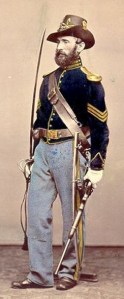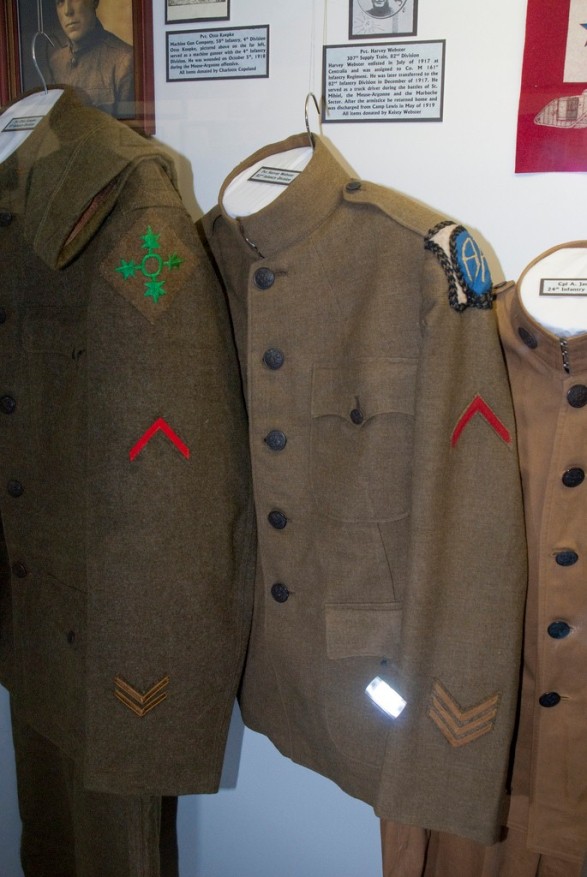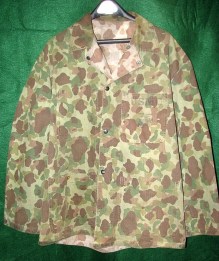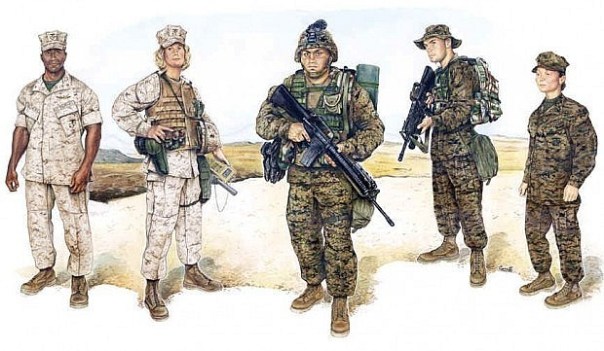Consistency through Change – The U.S. Army Uniform

This uniform, though an immediate post-Civil War-issue, is clearly that of a sergeant in the U.S. Cavalry as noted by the gold chevrons (hand-tinted in the photo).
Over the weekend leading up to Independence Day, I had been inspired by my family military service research project, which had me neck-deep in the American Civil War, which caused me to drag out a few DVDs for the sheer joy of watching history portrayed on the screen. Since the Fourth of July was coming up, I wanted to be sure to view director Ronald Maxwell’s 1993 film Gettysburg, on or near the anniversary of the battle, which took place on July 1-3, 1863.
I had watched these films (including Gods and Generals and Glory) countless times in the past, but this weekend, I employed more scrutiny while looking at the uniforms and other details. Paying particular attention to the fabrics of the uniforms, I was observing the variations for the different functions (such as artillerymen, cavalrymen, and infantry) while noting how the field commanders could observe from vantage points where these regiments were positioned, making any needed adjustments to counter the opponents’ movements or alignments. For those commanders, visual observations from afar were imperative and the uniforms (and regimental colors/flags) were mandatory to facilitate good decision making.
The tactics employed for the majority of the Civil War were largely carryovers from previous conflicts and had not kept pace with the advancement of the weaponry. Armies were still arranged in battle lines facing off with the enemy at very close range (the blue of the Union and the gray of the Confederacy), before the commands were given to open fire with the rifles and side arms. The projectile technology and barrel rifling present in the almost all of the infantry firearms meant that a significantly higher percentage of the bullets would strike the targets. In prior conflicts where smooth-bore muskets and round-ball projectiles were the norm, hitting the target was met with far less success.
The uniforms of the Civil War had also seen some advancement as they departed from the highly stylized affairs of the Revolution to a more functional design. In the years following the war, uniform designs saw some minor alterations through the Indian Wars and into the Spanish American War. By World War I, concealment and camouflaging the troops started to become a consideration of military leadership. Gone were the colorful fabrics, exchanged for olive drab (OD) green. By World War II, camo patterns began to emerge in combat uniforms for the army and marines, though they wouldn’t be fully available for all combat uniforms until the late 1970s.

Though these uniforms have a classy appearance, they were designed for and used in combat. Their OD green color was the precursor to camouflage.

This World War II-era USMC combat uniform top was made between 1942 and 1944. Note the reversible camo pattern can be seen inside the collar (source: GIJive).
For collectors, these pattern camouflage combat uniforms are some of the most highly sought items due to their scarcity and aesthetics. The units who wore the camo in WWII through the Viet Nam War tended to be more elite or highly specialized as their function dictated even better concealment than was afforded with the OD uniforms worn by regular troops.
Fast-forward to the present-day armed forces, where camouflage is now commonplace among all branches. The Navy, in 2007-2008, was the last to employ camo, a combination of varying shades of blue, for their utility uniforms citing the concealment benefits (of shipboard dirt and grime) the pattern affords sailors. All of the services have adopted the digital or pixellated camo that is either a direct-use or derivative of the Universal Camouflage Pattern (UCP) first employed (by the U.S.) with the Marine Corps when it debuted in 2002. Since then, collectors have been scouring the thrift and surplus shops, seeking to gather every digital camo uniform style along with like-patterned field gear and equipment.

The first of the U.S. Armed Forces to employ digital camouflage, the USMC was able to demonstrate successful concealment of their ranks in all combat theaters. Shown are the two variations, “Desert” on the left and “Woodland” on the right.
 After a very limited testing cycle and what appeared to be a rush to get their own digital camo pattern, the U.S. Army rolled out their ACU or Army Combat Uniform with troops that were deploying to Iraq in 2005. With nearly $5 billion (yes, that is a “B”) in outfitting their troops with uniforms, the army brass announced this week that they are abandoning the ACU for a different pattern citing poor concealment performance and ineffectiveness across all combat environments. With the news of the change, the army has decided upon the replacement pattern, known as MultiCam, which has already been in use exclusively in the Afghanistan theater.
After a very limited testing cycle and what appeared to be a rush to get their own digital camo pattern, the U.S. Army rolled out their ACU or Army Combat Uniform with troops that were deploying to Iraq in 2005. With nearly $5 billion (yes, that is a “B”) in outfitting their troops with uniforms, the army brass announced this week that they are abandoning the ACU for a different pattern citing poor concealment performance and ineffectiveness across all combat environments. With the news of the change, the army has decided upon the replacement pattern, known as MultiCam, which has already been in use exclusively in the Afghanistan theater.
For collectors of MultiCam, this could be both a boon (making the items abundantly available) and a detractor (the limited pattern was more difficult to obtain which tended to drive the prices up with the significant demand). For those who pursue ACU, it could take decades for prices to start climbing which means that stockpiling these uniforms could be a waste of time and resources. Only time will tell.
Since the Civil War, the U.S. Army uniform has one very consistent aspect that soldiers and collectors alike can hang their hat upon…change.
Posted on July 3, 2017, in Civil War, Persian Gulf, U.S. Army, USMC, World War I, World War II and tagged ACU, Civil War Cavalry Uniform, MARPAT, MultiCAM, USMC, World War I US Army Uniform, WWI, WWII, WWII USMC Camoflage Uniform. Bookmark the permalink. Leave a comment.
Leave a comment
Comments 0